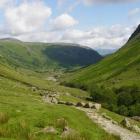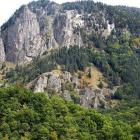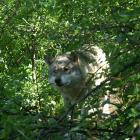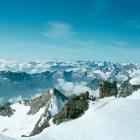Salvatge, verge, erm, and silvestre—Catalan
Catalan does not really have a word equivalent to the English understanding of “wilderness” that specifically focuses on a place or condition completely free of people. Although Catalans do not have a specific noun for describing this state, they do have adjectives to describe wilderness. These adjectives may have somewhat different meanings in each of the different geographical regions where Catalan is spoken: Catalonia (or Catalunya), Andorra, the Balearic Islands, Valencia (or Valencià), Northern Catalonia (in France), and L’Alguer (in Sardinia). Here we will focus on Catalonia.

The regions of Catalonia. Map by Marc Belzunces, 2007.
The regions of Catalonia. Map by Marc Belzunces, 2007.
Accessed via Wikipedia. Click here to view source.
 This work is licensed under a Creative Commons Attribution 3.0 Unported License.
This work is licensed under a Creative Commons Attribution 3.0 Unported License.
Examples of Catalan adjectives denoting “wild” include salvatge, verge, erm, and silvestre. These terms can be translated as “wild,” “virgin,” “uncultivated,” and “wildness,” respectively.

A place of salvatge: Montserrat mountain, Catalonia, Spain. Photograph by Luis Fernández, n.d.
A place of salvatge: Montserrat mountain, Catalonia, Spain. Photograph by Luis Fernández, n.d.
 This work is licensed under a Creative Commons Attribution-NonCommercial-ShareAlike 3.0 Unported License.
This work is licensed under a Creative Commons Attribution-NonCommercial-ShareAlike 3.0 Unported License.
If we look more closely at these words one understands that salvatge denotes something that is natural and has not been influenced by humans, and also refers to something that humans cannot control. Catalans can also use the term area verge or virgin zone, which refers to an area where humans have not had any influence. The origin of the word salvatge derives from the Latin word silvaticus, which is a quality that derives from the forest. The adjective form of salvatge can be understood in the way that Joan Frigolé (2012) used it: “natura salvatge” which is similar to “naturaleza salvaje” in Spanish (Ordovas 2009). However, these terms are more precisely understood as wild nature rather than wilderness.
As pointed out, these wilderness meanings stem from adjectives, but Catalan can also use these terms to describe phenomena beyond wilderness as a place. For example, in the practice of heraldry—a system of designing and recording coats of arms of famous families—a “salvatge” is a figure depicted as a naked man holding a mace and sprouting leaves from head and hip.
Lluís Duch (born 1936), a monk from the Abbey of Montserrat in Catalonia, refers to the myth of the “bon salvatge,” or “noble savage,” which is the personification of wilderness that is itself not tied to culture (Duch 2000). The bon salvatge is a person who is not influenced by human culture, being an expression of and behaving like nature, and commonly portrayed without clothing. Bougainville describes him or her as someone who does not eat meat. He or she is also associated with people living in small, isolated villages surrounded by natural bounty. Enciclopedia.cat describes the bon salvatge as someone strong and simple who lives in inaccessible places, inhabiting nature’s paradise.

Montseny mountain, Catalonia, Spain. Photo: Luis Fernández.
Montseny mountain, Catalonia, Spain. Photo: Luis Fernández.
 This work is licensed under a Creative Commons Attribution-NonCommercial-ShareAlike 3.0 Unported License.
This work is licensed under a Creative Commons Attribution-NonCommercial-ShareAlike 3.0 Unported License.
In Catalonia, the Pyrenees are probably the best embodiment or location of wilderness. The first prehistoric tribes arriving to the Pyrenees were Iberians, who were followed in the ninth century BCE by the Celts. The Pyrenees make up 5% of Catalonia’s territory (Boada 2006); its highest point is Pica d’Estats at 3,143 meters. As is typical in mountainous areas, the Catalonian Pyrenees show a wide range of temperature and vegetation. One can consider the Pyrenees the “wildest” place in Catalonia, as reflected in the seven national parks located there. These national parks provide a legal mechanism for maintaining the area free of contamination and human development. For most Catalans, these mountains are a place where one can go to see nature undisturbed by excessive civilization. However, the popularity of these mountains attracts large numbers of tourists, which reduces visitors’ impression of being immersed in the wild. The Pyrenees can nonetheless be considered an uninhabited forest and they are home to the largest fauna in Catalonia, including brown bears and chamois.
What does wilderness mean in your language? Browse “Wilderness Babel” via the map.
Live map showing the location of the languages featured in the virtual exhibition. What does wilderness mean in your language? Browse “Wilderness Babel” via the map.
- Boada, Martí. Perspectiva Socioecològica dels Nostres Boscos: 10è Aniversari del Centre Tecnòlogic Forestal de Catalunya. Solsona: Centre Tecnològic Forestal de Catalunya, 2006.
- Duch, Lluis. “El Mite del ‘Bon Salvatge’ l’Antropologia.” Anàlisi: Quaderns de Comunicació i Cultura 24 (2000), 185–200.
- Ordovas, Julio José. “Donde la Toscana se Asilvestra.” Altaïr 62 (Nov–Dec 2009): 66.

























